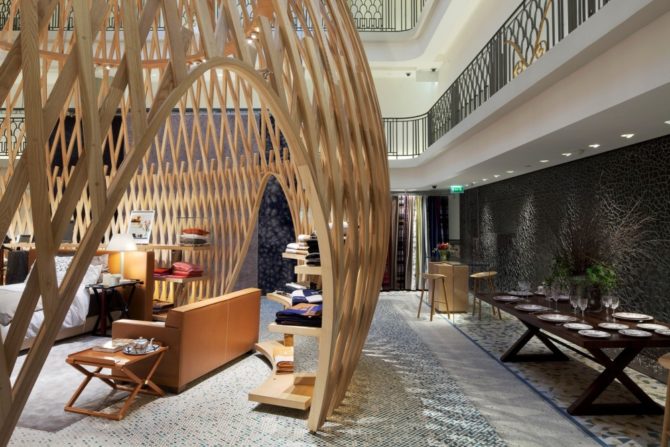Design Now

Swimming in Luxury
From the iconic Hermès flagship building on the rue du Faubourg Saint Honoré to its new Left Bank store on the rue de Sèvres is more than a geographical hop across the Seine. The striking transformation of the Piscine Lutetia, a 1935 landmark Art Deco swimming pool, into the first Hermès concept store signals a brand new universe for the luxury brand, stamped with all the firm’s originality and panache. It’s “the expression of Hermès today”, says creative director Pierre-Alexis Dumas, who is also a member of the Hermès family.
From the entrance level, a grand mosaic staircase descends to the main floor. Here, in a sky-lighted atrium, Denis Montel of RDAI—the architecture firm founded by Dumas’s late mother Rena—has filled the lower-level former pool space with swooping, 30-foot-tall, teepee-shaped openwork huts of woven pale ashwood.
Inside these warm wooden structures, floors of pale gray, white gold, green and silver mosaics evoke shimmering water, while those renowned Hermès luxury wares—from accessories and ready-to-wear to scarves and saddles—splash the neutral environment with color.
In a significant departure from the flagship store’s format, here the home decor collections occupy fully one third of the 15,800-square-foot space, not only porcelain, crystal, flatware and furniture but also new ventures into wallpaper, furnishing fabrics and silk carpets. The most intriguing addition is a revival of the company’s 1920s and 1930s collaboration with Art Deco legend Jean-Michel Frank, in an exclusive series of his designs including a dressing table sheathed in ivory kid parchment; his Comfortable cubist chairs and sofas in a range of leathers and fabrics; a dining table available in oak or rosewood; and coffee tables in leather, parchment, shagreen or sun-pattern straw marquetry.
Conceived to attract the denizens of the surrounding Saint Germain des Prés neighborhood, the store’s eclectic concept is evident right from the street-side display window—for the opening it blossomed with white lilacs from florist Baptiste Pitou’s selection of haute blooms just inside the store’s entrance. There’s a bookshop filled with international volumes on art, architecture, photography, biography and, bien sûr, the horse and all things equine. The tea salon—called Le Plongeoir (Diving Board)— features such snacks as Charolais beef carpaccio with black truffles and a selection of rare teas from the Palais des Thés. It’s all très Hermès.
17 rue de Sèvres, 6th, 01.42.22.80.83. website
Literary Refuge
In a modern echo of the “little Paris hotel” celebrated in story and song, the new Pavillon des Lettres, a sister hotel to the Pavillon de la Reine on the Place des Vosges, offers an alluring new theme and a great location. Just off the rue du Faubourg Saint Honoré and its luxury shopping, close to Christie’s and Sotheby’s auction houses and steps from the presidential Elysée Palace, the hotel’s 26 cozy rooms are named for 26 alphabetically chosen literary lions, from Hans Christian Andersen to Emile Zola by way of Victor Hugo, Henry James, Marcel Proust and William Shakespeare. Excerpts from each author’s works are stenciled on the walls, in rooms that French decorator Didier Benderli has cast in a warm palette of copper, cognac and brandy with touches of coral. Some suites offer views of the Eiffel Tower and Parisian rooftops. Bedtime reading comes with a contemporary twist: iPads are stocked not only with more literature from the room’s namesake writer, but also with a host of best sellers, along with jazz and classical music. More books crowd the shelves of the library/salon off the lobby, where novels, comic books or classics can be perused—accompanied by tea, coffee and snacks—on comfortable banquettes in front of a fire.
Rooms from €300. 12 rue des Saussaies, 8th, 01.49.24.26.26. website
Honor Roll
VIA, the French government and industry organization that promotes innovation in French design, annually awards VIA Labels to successful collaborations between designers and furniture manufacturers. The recent winning partnerships, on show in the Galerie VIA through February, range from experienced designers and well-known furniture producers to promising new talents and young firms.
Inga Sempé’s Ruché sofa caught all eyes on the stand of Ligne Roset, one of France’s outstanding contemporary furniture producers, at last year’s Maison et Objet trade fair. The stylish beech sofa, and its méridienne variation, are clad in quilted foam duvets whose technology makes them both “supple and strong,” explains Sempé, “with a lot of air and not much material”.
The Yumé chair came from the successful match of the venerable bentwood expertise of the Sièges Perrouin, a specialist in church furniture and period styles since 1875, and designer Jean-Marc Gady’s imaginative fusion of the curved natural bentwood form with a seat of cane or recyclable Batyline fabric.
The sleek Entaille commode, designed by Philippe Riehling in birch plywood and available in custom dimensions, was one of ten successful projects done in nine months by producer L’Edito, which organizes and finances co-editions by linking designers, production and development via the Internet.
Coulheur, a clock that tells time through color, was the brainchild of designer and producer Bettina Dadon. The 56 dials of her contemporary timepiece represent eight time periods from dawn to dusk and beyond for each day of the week in a correlation of time cycles with color movements.
Juan Pablo Naranjo and Jean-Christophe Orthlieb of the Studio Nocc thought up temporary but solid cardboard furniture for immediate use in emergency humanitarian aid. Made in partnership with packaging leaders Leafsupply & Smurfit Kappa, the Leaf Bed (which also includes a table and stool) is based on rigid triangular construction and can be quickly produced.
29 ave Daumesnil, 12th, 01.46.28.11.11. website
Designing Women
Andrée Putman, France’s dowager priestess of design, who recently handed over her studio to her daughter, Olivia, was the star of a retrospective at Paris’s Hôtel de Ville through Feb 26, 2011. The exhibit traced the milestones in the 85-year-old grande dame’s career, among them: her work with the avant-garde Prisunic plastic furniture team in the late 1960s; her Ecart International revival of the 1920/30s furniture of Modernist designers Robert Mallet-Stevens, Eileen Gray and Jean-Michel Frank in the 1970s; the interiors for the trendsetting Morgans Hotel in New York in 1984; and more recently her namesake Hotel Putman in Hong Kong. Along the way, Putman also designed silver for Christofle and interiors for the office of French Culture Minister Jacques Lang and the cabins of Air France’s Concorde. As videos and photographs, by Andy Warhol among others, testified, one of Putman’s most powerful creations was her own image.
Mairie de Paris, 5 rue Lobau, 1st, 01.42.76.40.40. website
Interior architect Caroline Sarkozy, who trained with Putman, has edited a new coffee-table tome, Living in Style Paris (published by teNeues, Germany), an insider peek into the privileged private spaces of the beau monde. Along with her own interior designs, Sarkozy—who is the stepsister of France’s president—has also included the work of such talented friends as decorators Jacques Grange, Tino Zervudachi and Hubert Le Gall, and antiquaires Yves Gastou and Pierre Passebon.
Available at the Galerie du Passage, 20 Galerie Véro-Dodat, 01.42.36.01.13.
View Design Now in a larger map
Originally published in the February 2011 issue of France Today.
Share to: Facebook Twitter LinkedIn Email
Leave a reply
Your email address will not be published. Required fields are marked *



